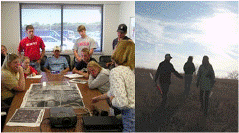Environmental and Sustainability Studies Program

Department of Environmental Studies: Undergraduate Student Theses
Date of this Version
Spring 5-2013
Document Type
Thesis
Abstract
This study 1) looked at how weather patterns are predicted to change as a result of global climate change, 2) considered how these changes could affect the survival of Piping Plovers, Interior Least Terns, and Whooping Cranes and 3) considered the importance of managing wildlife in the Great Plains in light of the predicted consequences of global climate change. Correlation (Spearman rs) tests were completed to compare the abundance of each species of birds and the amount of water flowing in the Platte River. Piping Plovers and Interior Least Terns have a specific amount of water that is not too high or too low, where their survival and reproduction is optimized. Both species rely on the same habitat on the Platte River for survival. The number of Whooping Cranes has been steadily increasing since they were placed on the endangered species list in 1985; they exhibit less reliance on the Platte River than do the plover and tern.

